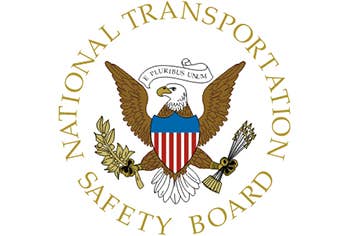
NTSB seal NTSB
The following is an excerpt from official NTSB summaries of general aviation accidents in the United States.
NTSB investigators either traveled in support of this investigation or conducted a significant amount of investigative work without any travel, and used data obtained from various sources to prepare this aircraft accident report.
Cessna 421B
Diboll, Texas/Injuries: 1 Serious, 2 Minor
The pilot reported that, after a flight the day before the accident, he requested that the fixed-base operator (FBO) top off the tip tanks with fuel. Before the accident flight the next morning, he performed a preflight inspection of the airplane; there was no water in the fuel sample, which appeared to be blue, similar to 100LL aviation fuel. The pilot performed an engine run-up before takeoff, and no anomalies were noted. During climbout, the airplane vibrated slightly, and the climb performance degraded. The airplane reached 2,100 feet above ground level, and the left engine then sputtered and lost all power. Shortly after, the right engine also lost all power, and the pilot conducted a forced landing to a highway median. The smell of Jet A fuel was prominent at the accident scene.
A post-accident examination of the reciprocating engines revealed that they exhibited signs of detonation, consistent with having been operated with Jet A fuel, and a review of fueling records revealed that the airplane had been serviced with Jet A fuel instead of the required 100LL aviation fuel. Further, the FBO employee who fueled the airplane reported that he mistakenly serviced the airplane with 53 gallons of Jet A fuel; examination of the fuel tank filler ports revealed placards next to the ports indicating that only 100LL fuel was to be used. A credit card receipt signed by the pilot also showed that the airplane was serviced with Jet A fuel. The FBO employee also noted that the nozzle on the Jet A fuel truck was small and round like the nozzle on the aviation gas fuel truck. According to the airport manager, the larger Jet A nozzle, which was J-shaped with an opening of 2 3/4 inches, had recently been switched to a smaller, round nozzle; switching to a smaller fuel nozzle increased the chances that aircraft that needed 100LL fuel could be misfueled with Jet A fuel.
The Federal Aviation Administration had issued an airworthiness directive (AD) about 26 years before the accident requiring that the filler ports be equipped with restrictors to preclude misfueling; the restrictors reduced the fuel filler diameter to 1 5/8 inches. A review of the airplane’s maintenance records indicated that the AD had been accomplished; however, an examination of the airplane revealed that it was not equipped with the required restrictors. Based on the evidence, the engine likely lost power due to the use of the improper fuel type. Further, the noncompliance with the AD increased the possibility that the airplane could be misfueled with Jet A fuel, as occurred before the accident.
Probable Cause: The total loss of engine power due to the use of an improper fuel type. Contributing to the accident were the servicing of the airplane with the improper fuel, noncompliance with an airworthiness directive, and the fuel nozzle installed on the fueling truck.

Sign-up for newsletters & special offers!
Get the latest FLYING stories & special offers delivered directly to your inbox






